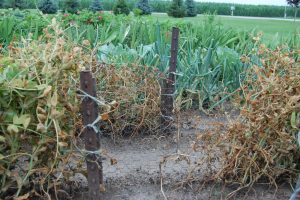
Garden peas
photo credit: Benita Bahler
Q. This year some of our peas started to die. This would start by the (rusty) post where my husband anchors a pea fence. Then the disease spread to other pea plants in the row. It went from the post and progressed east. The plants west of the post did not die. Attached please find a couple pictures. I’m sorry that I did not send this earlier, as all the plants are ready to die now since they are done producing. – B.B., Wolcott, Indiana
A. Peas are a decidedly cool-season crop and commonly stop blooming, scorch and die back as hot summer weather comes on. I don’t think being located next to the rusty fence posts is a factor. Peas are best grown as an early spring crop starting as early as the garden soil is dry enough to work in late March through April. Once the plants scorch and die back, you can replace with a more heat tolerant summer crop such as bush beans, pumpkins or sweet corn. Some gardeners have had success raising peas for a fall crop, but typically the soil is too hot in late summer to get the crop started early enough to beat the killing fall frost.
You’ll find additional information on planting dates in the “Indiana Vegetable Planting Calendar” from Purdue Extensionhttp://www.hort.purdue.edu/ext/ho-186.pdf.
Q. I’ll be 71 years old Sept. 21 and have tried to grow different types of gourds, especially “turk’s turban.” I have no trouble getting them to sprout. It’s when the gourds bloom and begin to produce the fruit. It looks as if the bloom has been pinched off (it’s a perfect cut). I have seen a type of wasp on them right around the time of starting to produce. Could you tell me anything at all?
A. Gourds belong to a group of plants known as the cucurbits and includes squash, pumpkins, cucumbers and melons.
All of these vine crops produce separate male and female flowers, but usually there are both types on the same plant. In order for a fruit to be produced, pollen must be successfully transferred from the male flower to the female flower, usually by bees. After releasing their pollen, the male flower will fall off the plant. Only female flowers will produce a fruit if successfully fertilized by pollen. If pollen does not successfully unite with the egg cells within the female flowers, then no fruit will be produced and the female flowers will abort.
It is easy to tell the difference between female and male flowers in this group of plants. Female flowers look as if they have a miniature fruit (squash, cucumber, gourd, etc.) just below where the petals are attached. Male flowers simply have a slender stalk below the petals.
Often, the very first flush of flowers early in the growing season will only be males, and, of course, these male flowers are expected to fall off after pollen is shed. The next flush of flowers should include both male and female flowers.
However, if female flowers are the ones dropping, then it is safe to conclude that some factor is preventing successful pollination. The most common culprits include excessively hot or cold temperatures and lack of bee activity due to weather, low population, or use of insecticides for pest control.